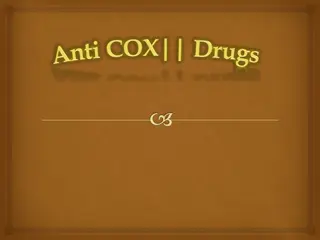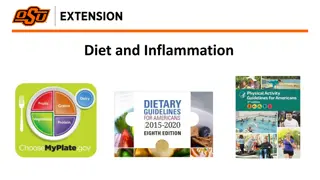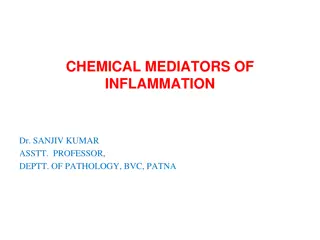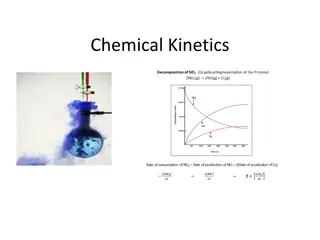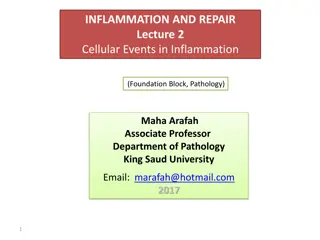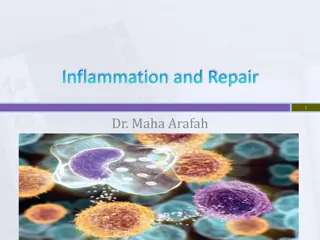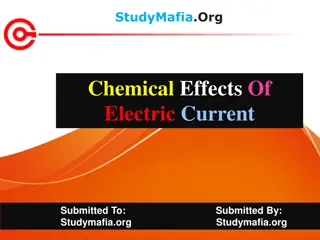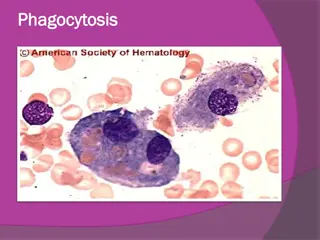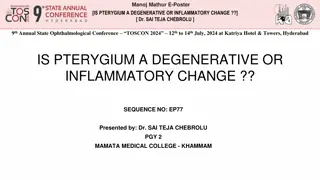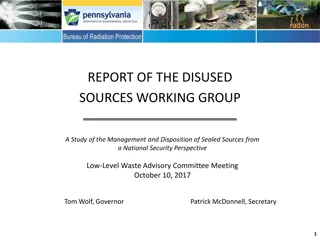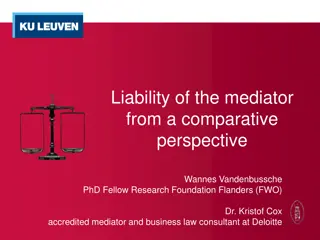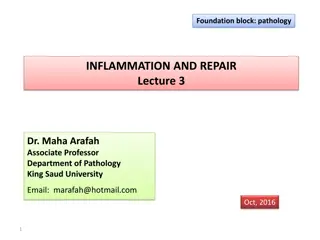Chemical Mediators of Inflammation: Understanding Sources and Effects
Chemical mediators of inflammation play a pivotal role in inducing specific events during acute inflammation. These mediators are produced in response to various triggers, including microbial products and host proteins, leading to a cascade of inflammatory responses. Understanding the sources and effects of these mediators is crucial in comprehending the complex nature of the inflammatory process and its systemic manifestations. The regulation of mediator function is essential to prevent harmful effects, highlighting the delicate balance required for a controlled inflammatory response.
Download Presentation

Please find below an Image/Link to download the presentation.
The content on the website is provided AS IS for your information and personal use only. It may not be sold, licensed, or shared on other websites without obtaining consent from the author. Download presentation by click this link. If you encounter any issues during the download, it is possible that the publisher has removed the file from their server.
E N D
Presentation Transcript
Foundation Block, Pathology INFLAMMATION AND REPAIR Lecture 4 Chemical mediator of inflammation Systemic effect of inflammation Oct 2018 Dr. Maha Arafah Associate Professor Department of Pathology King Khalid University Hospital and King Saud University Email: marafah@ksu.edu.sa marafah @hotmail.com Robbins Basic Pathology 10thedition Pages: 70 to 78
Objectives 1. Chemical mediators of inflammation: I. Definition II. Know the general principles for chemical mediators. III. Know the cellular sources and major effects of the mediators. IV. List the most likely mediators of each of the steps of inflammation. 2. Describe the systemic manifestations of inflammation and their general physiology, including fever, leukocyte left shift, and acute phase reactants. 2
Chemical mediators of inflammation What are mediators? Chemical mediators of inflammation are substances produced during inflammation inducing a specific events in acute inflammation.
Chemical mediators of inflammation General principles for chemical mediators The production of active mediators is triggered by: 1. microbial products 2.host proteins, such as the proteins of the complement, kinin and coagulation systems (these are themselves activated by microbes and damaged tissues)
General principles for chemical mediators Most mediators have the potential to cause harmful effects. - Therefore, there should be a mechanism to checks and balances their action. Mediator function is tightly regulated by: 1) decay (e.g. AA metabolites) 2) inactivated by enzymes (kininase inactivates bradykinin) 3) eliminated ( antioxidants scavenge toxic oxygen metabolites)
Chemical mediators of inflammation Source of Chemical mediators Cell-derived: 1. Synthesized as needed (prostaglandin) 2. Preformed, sequestered and released (mast cell histamine) Plasma-derived: 1. Complement 2. kinins 3. coagulation factors Many in pro-form requiring activation (enzymatic cleavage)
Chemical mediators of inflammation Chemical Mediators of Inflammation Cell-Derived Plasma-Protein-Derived Vasoactive Amines Eicosanoids PAF Cytokines Chemokines ROS NO Lysosomal Enzymes of Leukocytes Neuropeptides
Chemical mediators of inflammation Chemical Mediators of Inflammation Plasma-Protein- Derived Cell-Derived Complement Coagulation and Kinin Systems
Chemical mediators of inflammation: cell derived Cell-Derived Mediators Producing cells: Tissue macrophages Mast cells Endothelial cells Leukocytes
3. Chemical mediators of inflammation Chemical mediators of inflammation: cell derived Vasoactive Amines Histamine & Serotonin Among first mediators in acute inflammatory reactions Preformed mediators in secretory granules
Chemical mediators of inflammation: cell derived Histamine plays a major role in the early phase of acute inflammation and increases vascular permeability Source: many cell types, esp. mast cells, circulating basophils, and platelets Stimuli of Release: Physical injury Immune reactions C3a and C5a fragments Cytokines (e.g. IL-1 and IL-8) Neuropeptides Actions: ARTERIOLAR DILATION INCREASED VASCULAR PERMEABILITY (venular gaps) ENDOTHELIAL ACTIVATION 1. 2. 3. Inactivated by: Histaminase
3. Chemical mediators of inflammation Chemical mediators of inflammation: cell derived Serotonin (5-HT) Source: Platelets Action: Similar to histamine Stimulus: Platelet aggregation
Chemical mediators of inflammation: cell derived Source: Leukocytes Mast cells Endothelial cells Platelets Arachidonic Acid Metabolites (eicosanoids)
Chemical mediators of inflammation: cell derived Chemical Mediators of Inflammation Cell-Derived Plasma-Protein-Derived Vasoactive Amines Eicosanoids PAF Cytokines Chemokines ROS NO Lysosomal Enzymes of Leukocytes
3. Chemical mediators of inflammation Chemical mediators of inflammation: cell derived Chemical Mediators of Inflammation Cell-Derived Plasma-Protein-Derived Vasoactive Amines Cytokines Polypeptides Actions: Involved in early immune and inflammatory reactions Some stimulate bone marrow precursors to produce more leukocytes Have roles in acute and chronic inflammation Eicosanoids PAF Cytokines Chemokines ROS NO Lysosomal Enzymes of Leukocytes Neuropeptides
Chemical mediators of inflammation: cell derived Cytokine of Acute inflammation: Interleukin (IL-1) & TNF
Chemical mediators of inflammation: cell derived Cytokines of Interferon- (INF- ) & Interleukin ( IL-12) Chronic Inflammation: Activated lymphocytes and macrophages influence each other and also release inflammatory mediators that affect other cells.
Chemical mediators of inflammation: cell derived Chemical Mediators of Inflammation Cell-Derived Plasma-Protein-Derived Vasoactive Amines Chemokines Small proteins They are chemoattractants for leukocytes Main functions: Leukocyte recruitment & activation in inflammation Normal anatomic organization of cells in lymphoid and other tissues Eicosanoids PAF Cytokines Chemokines ROS NO Lysosomal Enzymes of Leukocytes Neuropeptides
Chemical mediators of inflammation: cell derived Chemical Mediators of Inflammation Cell-Derived Reactive Oxygen Species Synthesized via NADPH oxidase pathway Source: Neutrophils and Macrophages Stimuli of release: Microbes Immune complexes Cytokines Action: Microbicidial (cytotoxic) agent Plasma-Protein-Derived Vasoactive Amines Eicosanoids PAF Cytokines Chemokines ROS NO Lysosomal Enzymes of Leukocytes Neuropeptides
3. Chemical mediators of inflammation Chemical Mediators of Inflammation Cell-Derived Nitric Oxide ( NO) Short-lived Soluble free-radical gas Functions: Vasodilation Antagonism of platelet activation (adhesion, aggregation, & degranulation) Reduction of leukocyte recruitment Microbicidial (cytotoxic) agent (with or without ROS) in activated macrophages Plasma-Protein-Derived Vasoactive Amines Eicosanoids PAF Cytokines Chemokines ROS NO Lysosomal Enzymes of Leukocytes Neuropeptides
Chemical mediators of inflammation: cell derived 1 2 Actions of Nitric Oxide 3 4
Chemical mediators of inflammation: cell derived Chemical Mediators of Inflammation Cell-Derived Plasma-Protein-Derived Lysosomal Enzymes of Leukocytes Neutrophils & Monocytes Enzymes: Acid proteases Neutral proteases (e.g. elastase, collagenase, & cathepsin) Vasoactive Amines Eicosanoids PAF Cytokines Chemokines ROS Their action is checked by: Serum antiproteases (e.g. 1-antitrypsin) NO Lysosomal Enzymes of Leukocytes Neuropeptides
Chemical mediators of inflammation: cell derived Chemical Mediators of Inflammation Cell-Derived Neuropeptides Small proteins Secreted by nerve fibers mainly in lung & GIT Initiate inflammatory response e.g. Substance P : Transmits pain signals Regulates vessel tone Modulates vascular permeability Plasma-Protein-Derived Vasoactive Amines Eicosanoids PAF Cytokines Chemokines ROS NO Lysosomal Enzymes of Leukocytes Neuropeptides
Chemical mediators of inflammation: Plasma protein derived Chemical Mediators of Inflammation Plasma-Protein- Derived Cell-Derived Complement Coagulation and Kinin Systems
Chemical mediators of inflammation: Plasma protein derived PLASMA PROTEASES A variety of phenomena in the inflammatory response are mediated by plasma proteins that belong to three interrelated systems 1. Kinin 2. Complement 3. Clotting systems
Chemical mediators of inflammation: Plasma protein derived Complement System
Chemical mediators of inflammation: Plasma protein derived Complement protein C3a & C5a Increase vascular permeability ( anaphylatoxins) C5a Chemotaxis C3b Opsonization C5-9 membrane attack complex
Prostaglandins Histamine Nitric oxide Vasoactive amines Bradykinin Leukotrienes C4, D4, E4 PAF Substance P C5a Leukotriene B4 Chemokines IL-1, TNF Bacterial products IL-1, TNF Prostaglandins Vasodilation Role of Mediators in Different Reactions of Inflammation Increased vascular permeability Chemotaxis, leukocyte recruitment and activation Fever Pain Prostaglandins Bradykinin Tissue damage Neutrophil and macrophage lysosomal enzymes Oxygen metabolites Nitric oxide
Mediators Source Principal Actions The Actions of the Principal Mediators : Cell-Derived Mast cells, basophils, platelets Platelets Serotonin Histamine Vasodilation, increased vascular permeability, endothelial activation Vasodilatation, increased vascular permeability. Vasodilatation, pain, fever. Prostaglandins Mast cells, leukocytes Leukotrienes Mast cells, leukocytes Increased vascular permeability, chemotaxis, leukocyte adhesion and activation. Vasodilatation, increased vascular permeability, leukocyte adhesion, chemotaxis, degranulation, oxidative burst Platelet- activating factor Leukocytes, endothelial cells Reactive oxygen species Nitric oxide Leukocytes Killing of microbes, tissue damage Endothelium, macrophages Vascular smooth muscle relaxation; killing of microbes Cytokines (e.g. TNF, IL-) Macrophages, lymphocytes Endothelial cells, mast cells Local endothelial activation (expres-sion of adhesion molecules), systemic acute- phase response in severe infections, septic shock
Systemic manifestations of inflammation Systemic effects of Inflammation Liver - IL-6, IL-1, TNF Acute phase proteins C-reactive protein Lipopolysaccharide binding protein Serum amyloid A a-2 macroglobulin Haptoglobin Ceruloplasmin fibrinogen Acute phase reaction/response - IL-1 and TNF Fever Malaise Anorexia Bone marrow - IL-1 + TNF Leukocytosis Lymphoid organs
Systemic manifestations of inflammation Fever Produced in response to Pyrogens Types of Pyrogens: Exogenous pyrogens: Bacterial products Endogenous pyrogens: Interleukin 1 (IL1) and Tumour necrosis factor (TNF) Bacterial products stimulate leukocytes to release cytokines such as IL-1 and TNF that increase the enzymes (cyclooxygenases) that convert AA into prostaglandins. Chemical mediators which are the inducing cause of fever are: 1. IL-1 2. TNF 3. Prostaglandins
Systemic manifestations of inflammation Fever In the hypothalamus, the prostaglandins, especially PGE2, stimulate the production of neurotransmitters such as cyclic AMP, which function to reset the temperature set-point at a higher level. NSAIDs, including aspirin , reduce fever by inhibiting cyclooxygenase and thus blocking prostaglandin synthesis.
Systemic manifestations of inflammation Leukocytosis Shift to left
Systemic manifestations of inflammation Inflammation Systemic Manifestations Leukocytosis: WBC count climbs to 15,000 or 20,000 cells/ l most bacterial infection (Neutrophil) Lymphocytosis: Viral infections: Infectious mononucleosis, mumps, German measles ( Lymphocytes) Eosinophilia: bronchial asthma, hay fever, parasitic infestations Leukopenia: typhoid fever, infection with rickettsiae/protozoa
Systemic manifestations of inflammation C-reactive protein (CRP) Lipopolysaccharide binding protein Serum amyloid A (SAA) a-2 macroglobulin Haptoglobin Ceruloplasmin fibrinogen CRP and SAA, bind to microbial cell walls, and they may act as opsonins and fix complement
Acute phase proteins Elevated serum levels of CRP serve as a marker for acute inflammation and increased risk of myocardial infarction in patients with coronary artery disease. Prolonged production of these proteins (especially SAA) in states of chronic inflammation can cause: secondary amyloidosis
Systemic manifestations of inflammation Increased erythrocyte sedimentation rate (ESR) The rise in fibrinogen causes erythrocytes to form stacks (rouleaux) that sediment more rapidly at unit gravity than do individual erythrocytes. (ESR) TNF IL-1 IL-6 Hepatic synthesis of some plasma proteins most notably fibrinogen Rapid agglutination of erythrocytes
Systemic manifestations of inflammation Erythrocyte sedimentation rate (ESR) This is a simple test for an inflammatory response caused by any stimulus. Fibrinogen binds to red cells and causes them to form stacks (rouleaux) that sediment more rapidly at unit gravity than do individual red cell
Summary 1. Chemical mediator of inflammation 2. The systemic manifestations of inflammation include fever, leukocyte left shift, and acute phase reactants. 43


